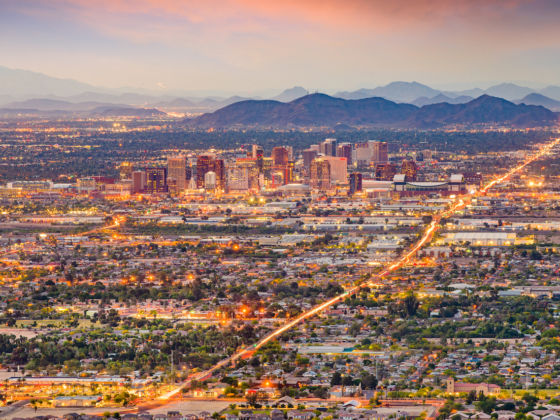

Sitting in the middle of the Sonoran Desert, you might not expect much from a city like Phoenix. Yet the sprawling capital of Arizona is home to world-class museums, diverse restaurants featuring local ingredients, and nature preserves with miles upon miles of hiking and biking trails. With its clear, sunny skies, unusual landscapes showcasing giant saguaros, a cultural scene that includes street muralists and indigenous artists, and a vibrant food and drink scene that’s always innovating, the city attracts thousands of visitors. And once here, most don’t want to leave, making Phoenix one of the fastest-growing cities in the US. No matter if you come to visit or to stay, this ultimate guide will help you make the best of your time here.
During the winter months, when everywhere else is cold and dark, Phoenix is the place to be. With temperatures hovering in the low 70s during the day, perfect sunshine and low humidity, it is the time to enjoy the desert environment in and around the city. The downside of visiting in the winter is that it can be very crowded and the price of accommodation can skyrocket. Though shorter than in most places, the shoulder seasons offer the chance to see a colorful desert while enjoying the warm weather. Lasting between mid-February and mid-April, spring is the most beautiful, when desert wildflowers and cacti bloom, adding a layer of brighter color to the green of the desert you see in the winter. Fall, when some desert plants bloom again, also offers perfect weather and green surroundings. Summer, lasting from May to October, has temperatures above 105 degrees on most days and is the time to avoid Phoenix. July and August bring either torrential rain, with accompanying flash floods, or dust storms, when visibility is near zero and city streets turn into sandy beaches. On the other hand, accommodations are cheaper and the city has plenty of water parks and indoor activities to choose from. So if you plan on spending all day in an air-conditioned spa, you’ll save plenty of money on flights and accommodation to splurge on a fancy treatment.
Being close to the border, and once part of Mexico, you’ll hear a lot of Spanish in Phoenix, though you don’t need to speak the language to get along in the city. The city’s population is about 30 percent Hispanic, but you’ll rarely encounter someone who doesn’t speak English.
With the exception of the mountains and desert preserves, Phoenix is flat and easy to navigate. The roads run on a grid system, East-West and North-South, which makes it hard to get lost, no matter if you drive, bike, or use public transport. Unless your destination is in the city center, you have limited choices of public transport for a city of this size. The Valley Metro is the main public transit system in the city, and it operates buses, light rail, and vanpool services. The Valley Metro Rail runs one line from Mesa to Northwest Phoenix, through Tempe. Though it covers a great distance, and it is reliable, it only runs on one narrow corridor. The bus system runs through most major parts of the city, though stops are few. Both buses and the light rail have come a long way in the past few years, but getting to a specific destination still requires Uber or Lyft, unless you have a car. The city was built on the presumption that everyone drives or rides a car so that’s still the easiest and most convenient way to get around. Bicycling is increasingly popular, with bike lanes on most city streets. Though these lanes are widely used in the winter and shoulder seasons, you won’t see many bicyclists in the heat of the summer months. Public transportation to and from the airport became easier in the past few years, thanks to the Sky Train that runs between the terminals and to the center of the city, to 44th Street and Washington, where it connects to the Valley Metro Rail. A few airport shuttles offer door-to-door service 24/7 at a reasonable price.
With a population of about 7 million, Phoenix is the fifth most populated city in the US, and, like any major city, it has good and bad parts. Crime rates vary by neighborhoods; North Phoenix, Scottsdale, and Paradise Valley are safer than South and Southwest Phoenix. The city is notorious for car theft though, so be aware of where you park your car, make sure to lock it, and don’t leave valuables visible inside. But overall, Phoenix is a relatively safe city for visitors, as long as you stay alert and use common sense like you would in any large city.
The future is autonomous.
“This is what travel should be,” I thought.
From hikers to golfers and partyers, these Airbnbs will satisfy just about every traveler.
There's more than one way to get baked in Phoenix.
Cheers to the future.
This hotel will give you a new vision of Phoenix.
It's like Coachella meets the Masters, held every February in Arizona.
Camping in the desert Southwest is a joy, but this unique landscape comes with its own special challenges. Join Wade and Abby for this fun look at the 8 most important tips for off-grid camping in the desert.